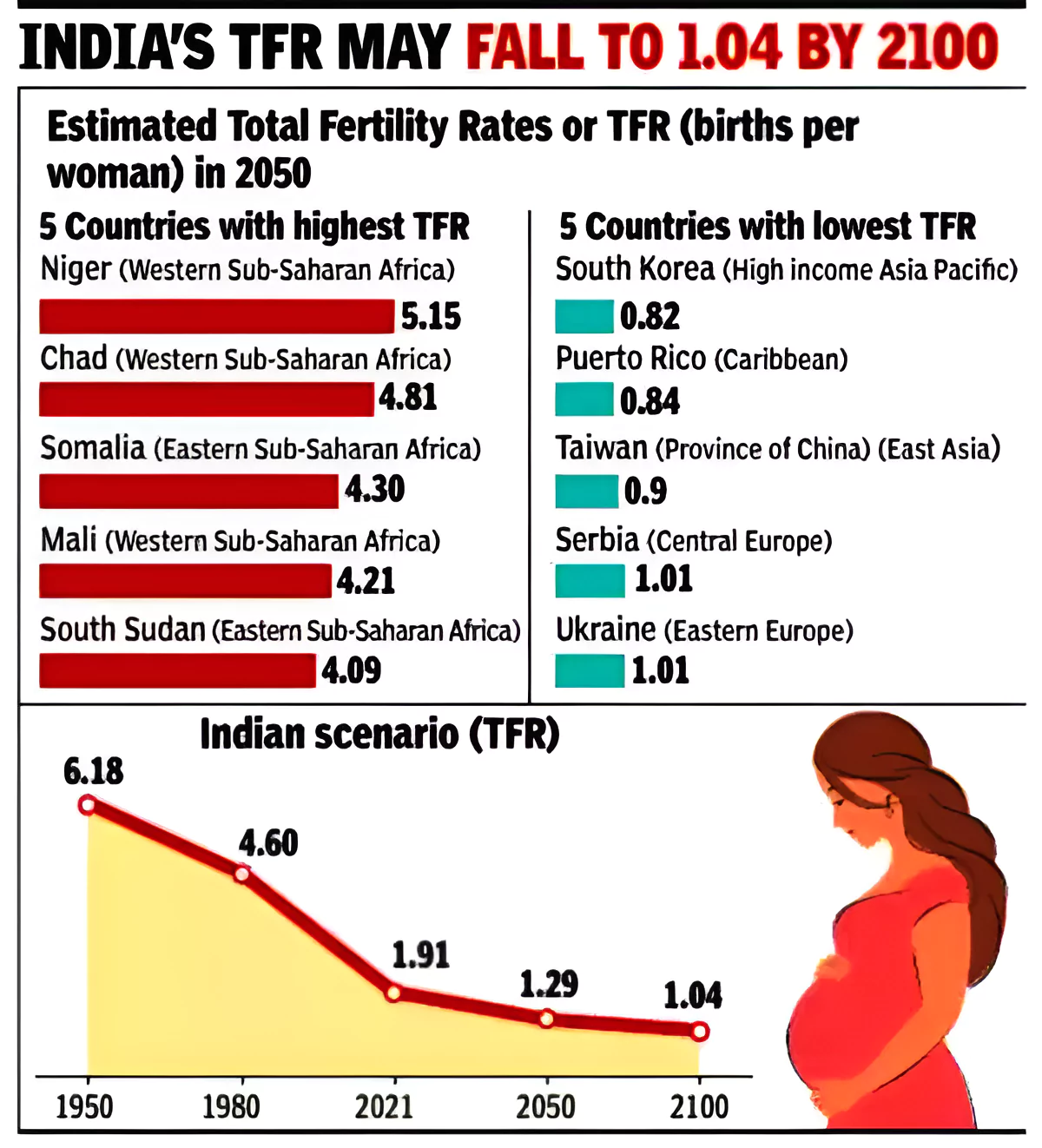Context

Recently, A Study Published in the Lancet which flagged India’s total fertility rate (TFR) (representing the average number of children born to each woman will fall to 1.29 in 2050, significantly below the replacement threshold of 2.1.
Fertility Rate in India: Key Findings of the Lancet Study
-
Global Trends:
- TFR Evolution: Between 1950 and 2021, the global total fertility rate (TFR) decreased by more than half, dropping from approximately 5 children per woman in 1950 to 2.2 children in 2021.
- Future Projection: A continued global decline, with an estimated global total fertility rate (TFR) of 1.83 by 2050 (about 76% of the countries will have TFR below replacement threshold ) and 1.59 by 2100 ( about 97% of the countries will have TFR below replacement threshold).
-
Regional Shift in Live Birth towards Sub-Saharan Africa:
- In 1950, one-third of global live births were in Southeast Asia, East Asia, and Oceania. Since 2011, the majority has shifted to sub-Saharan Africa, rising from 8% in 1950 to nearly 30% by 2021.
- Chinese Example: China’s working-age population surpassed 50% in 1987, coinciding with a period of significant economic growth. However, China’s total fertility rate (TFR) has declined to a record low, leading to a contraction in the working-age population.
-
Trends in India:
- TFR Evolution: In India, the total fertility rate (TFR) stood at 6.18 in 1950, dropped to 4.60 in 1980, and subsequently decreased to 1.91 by 2021.
- Future Projection:
- By 2050, one in five people in India will be above the age of 60 in 2050, signaling a transition towards an aging population akin to the demographic challenges currently faced by China.
- Earlier, the UN Population Fund’s (UNPF) ‘India Ageing Report’ also projected the number of elderly in India will more than double from 149 million in 2022 to 347 million by mid-century .
- Demographic Shift: The varying TFR rates across states in India as South & Western India are graying faster than those in the North.
Total Fertility Rate (TFR)
- The number of live births per woman completing her reproductive life, if her childbearing at each age reflects the current age-specific fertility rates (typically 15-49 Year).
Replacement Level Fertility
- It is the level of fertility at which a population exactly replaces itself from one generation to the next. In developed countries, replacement level fertility can be taken as requiring an average of 2.1 children per woman.
NFHS-5, 2019-21
- Total Fertility Rate (TFR) has declined from 2.2 in 2015-16 to 2.0 in 2019-21.
- Maximum TFR States wise: Bihar (2.98), Meghalaya (2.91), Uttar Pradesh (2.35), Jharkhand (2.26) and Manipur (2.17).
|
Reasons for Declining Fertility Rate in India
- Impact of Healthcare Programmes: Maternal and child health initiatives such as the availability of contraceptives and increased awareness of Family Welfare Programme and successful immunization campaigns, have contributed to the assurance of child survival and to maintain smaller family sizes.
- Economic Influences: Due dynamics of inter-generational wealth transfer & increasing expenses associated with living and child-rearing could discourage couples from opting for larger families.
- Empowerment of Women:
- Advancements in female literacy rates and increased participation of women in the workforce have empowered women to make more informed decisions about family planning.
- Changing Perspectives in Urban and Rural Areas: In Urban Areas, Trends of women viewing child-rearing as optional rather than obligatory & Some women are exploring alternatives like adoption. Similar trend is also emerging in rural parts of India, indicating a shift in societal norms and attitudes towards family planning.
Long Term Consequences of Declining Fertility Rate:
- Shortage of Working Age Population: Shortage of Manpower will further hinders the nation’s growth.
- Increase of Elderly Population: Increase in the burden of economic dependency & Health care facility to them.
- Irreversal Trend: Historical data from developed nations suggests that once fertility rates drop below the replacement level, reversing the trend becomes exceedingly difficult.
- Skewed Sex Ratio & Gender imbalance: low fertility level may deteriorate the sex ratio & Gender equality.
Way Ahead
- Maximizing Demographic Dividend: The demographic dividend is not everlasting. Insights from global experiences can guide policymakers in shaping strategies.
- Opportunity for India: UNPF projections indicate that India’s working-age population will peak in the late 2030s to early 2040s.
- Action Plan: Policymakers should prioritize measures to address skill gaps and bolster the knowledge economy. Efforts to create employment opportunities outside of agriculture, particularly in the formal sector etc.
- Preparing for Aging Population: Future policies must focus on ensuring adequate social security and healthcare provisions & Leveraging their skills for the growing elderly population will be essential.
Also Read: Government Panel to Look Into India’s Demographic Challenges
![]() 29 Mar 2024
29 Mar 2024

